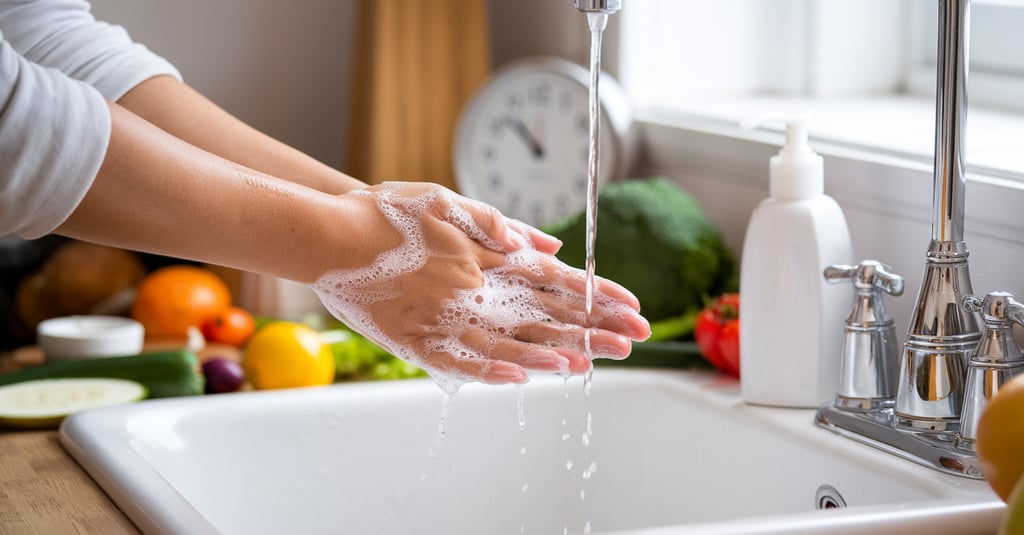How to Avoid Cross Contamination: Essential Tips You Need to Know
Sometimes, a reminder is just what we need — especially when it comes to food safety! While we’ve covered bacterial cross-contamination in a previous post, it's worth repeating: some habits are too critical to leave to chance. Today, we’ll dive deeper into how to avoid cross-contamination in your kitchen and food preparation areas, sharing fresh tips, practical examples, and expert advice to keep your meals safe and healthy.
4/26/20253 min read


What Exactly is Cross Contamination?
Cross-contamination isn’t just a restaurant or commercial kitchen problem — it happens in home kitchens every day.
According to health agencies, millions of foodborne illness cases every year could be prevented simply by better hygiene and food handling practices.
When it comes to your family’s health, prevention is everything.
1. Separate Raw and Cooked Foods
One of the golden rules:
✔ Keep raw foods and cooked/ready-to-eat foods apart at every stage — from shopping, to storage, to preparation, and serving.
Use different plates for raw meat and cooked meat.
Never reuse marinades used on raw foods without boiling them first.
Separate utensils, cutting boards, and cloths should be designated for raw and cooked foods.
Pro Tip:
Color-coding your utensils (like red for raw meat, green for vegetables) makes it easy to avoid mistakes!
2. Smart Refrigerator Storage
Ideally, if possible, use two refrigerators-one for raw foods and another for cooked or ready-to-eat foods.
If that’s not an option, remember:
Store raw meat, poultry, and seafood below cooked or ready-to-eat foods.
Always use sealed containers to prevent juices from leaking onto other items.
Regularly clean your refrigerator-spills can become bacterial breeding grounds!
Affiliate Tip:
Looking for leak-proof food containers? Check out these best-rated storage containers here.
3. Safe Food Preparation Surfaces
Before and after preparing raw foods, always:
Clean counters, cutting boards, and knives with hot water and detergent.
Disinfect if switching between raw and cooked foods.
Use disposable paper towels for cleaning surfaces, or thoroughly launder cloth towels after each use.
Shared food prep areas should be thoroughly disinfected when changing from raw food tasks to cooked or ready-to-eat food prep.
4. Special Care for Eggs
Pooling eggs (cracking several into a bowl) is convenient, but handle pooled eggs with caution:
Avoid spilling egg on counters or nearby foods.
Wash utensils, bowls, and surfaces after pooling.
Refrigerate pooled eggs promptly if not used immediately.
5. Handle High-Risk Foods Carefully
Certain foods are particularly risky and require extra care:
Raw poultry
Raw shellfish and oysters
Raw or undercooked beef
Raw or lightly cooked eggs
Leafy greens and sprouts
Use separate utensils, surfaces, and sometimes even preparation areas for these foods.
Special Note: Preparing sushi, sashimi, or raw oysters? You must disinfect surfaces between different preparation stages.
6. Proper Ingredient Storage
Store powdery ingredients, spices, and dried foods in dry, sealed containers.
Avoid wet spoons in dry goods-moisture can introduce bacteria and cause Mold.
Use a clean spoon for every taste test!
7. Personal Hygiene is Non-Negotiable
We know, we’ve said it before — but handwashing truly is your first defence!
Wash hands thoroughly with soap and warm water before and after handling food, especially raw food.
Dry hands with clean towels or paper towels.
Wear clean work clothing when cooking.
If you use gloves, change them frequently — they are not magic shields!
Avoid touching your phone, face, or hair while cooking.
Affiliate Tip:
Upgrade your hygiene routine with this antibacterial liquid hand soap - a small change that can make a huge difference!
8. Clean Equipment = Safe Equipment
Bacteria can live on surfaces for hours or even days!
Always clean:
Knives
Cutting boards
Mixing bowls
Countertops
Blender or food processor parts
Before and after every use - not just when switching between foods!
9. Watch Out for Cross-Contamination Hotspots
Certain areas can become contaminated easily if you’re not careful:
Sink and faucet handles
Refrigerator handles
Trash can lid
Kitchen towels and sponges
Disinfect high-touch surfaces regularly, especially after preparing raw meat or poultry.
10. When Feeling Sick... Step Away!
If you feel ill (even a mild fever, diarrhea, or vomiting), do not handle food.
Seek medical advice first - you can unknowingly pass pathogens onto everything you touch.
Quick Summary: Top 10 Ways to Avoid Cross Contamination
Tip Action
Separate raw and cooked food
Store smart in your refrigerator
Clean prep surfaces thoroughly
Handle pooled eggs with care
Watch high-risk foods
Store dry goods properly
Maintain perfect personal hygiene
Keep kitchen equipment spotless
Watch hidden hotspots
Don’t cook while sick
Cross-contamination may sound scary, but preventing it is simple with the right habits.
Stay clean, stay aware, and protect your family’s meals every day
Join us on Pinterest
letstalk@lorybs.com
© 2025. All rights reserved.
